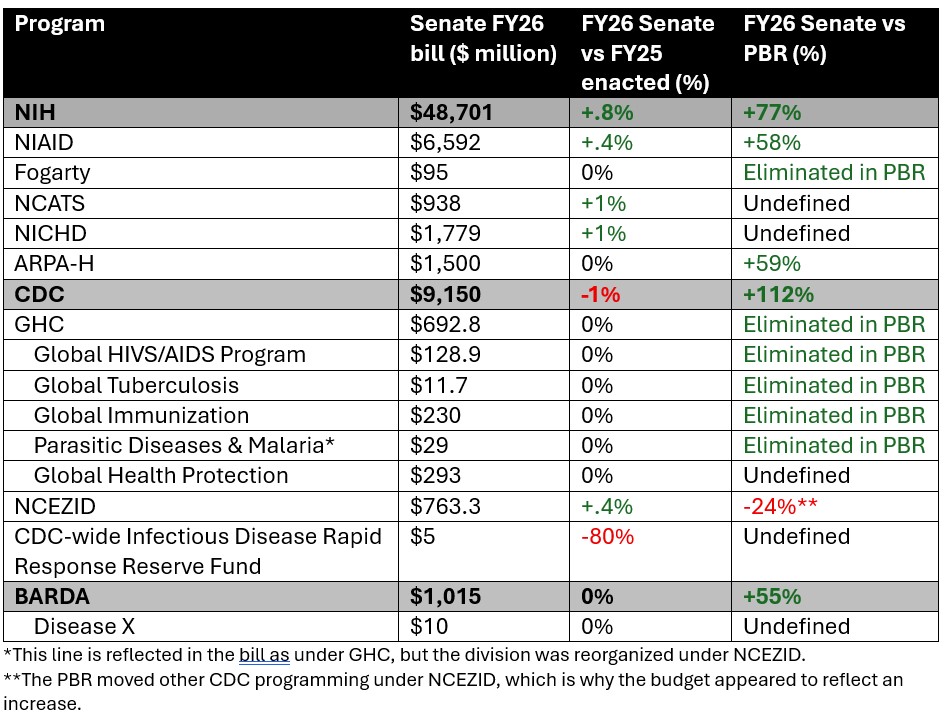On Thursday, Senate appropriators advanced out of committee a fiscal year (FY) 2026 spending bill for the Department of Health and Human Services (HHS) that rejects billions in health spending cuts proposed by the Trump Administration and protects programs vital to global health innovation.
The bill increases or flat-funds global health research-relevant agencies, including the National Institutes of Health (NIH) and Biomedical Advanced Research and Development Authority (BARDA), and slightly reduces funding for the US Centers for Disease Control and Prevention (CDC) compared to FY25 enacted—an outcome that is in stark contrast to the President’s Budget Request (PBR), which proposed deep cuts across all three. Funding at this level will enable these agencies to continue to advance medical breakthroughs and operate programs that deliver better health outcomes for people around the world and fortify our defenses against disease threats.
Funding highlights
The legislation allocates $48.7 billion in funding for NIH, which is a $400 million (.8 percent) increase compared to FY25 enacted and nearly $22.2 billion (77 percent) above the PBR, and $1.015 billion for BARDA, which represents level funding from FY25 but $361 million (55 percent) more than the White House request. While the legislation unfortunately cuts funding for CDC by $72 million, or 1 percent, this allocation is $4.8 billion or 112 percent greater than the President’s request.
While advocates expected the Senate to reject the steep cuts proposed by the Trump Administration, many still anticipated significant reductions. It is therefore both welcome and surprising that Senate appropriators advanced a spending package that maintains strong funding for many programs the President aimed to slash or eliminate.
Beyond topline funding for agencies, the bill and accompanying report also diverge from the PBR in other crucial ways. While the President proposed eliminating the CDC Global Health Center (GHC), this spending bill keeps the center intact, maintaining level funding from FY25.
The bill also maintains flat funding for the NIH Fogarty International Center—which supports global health research partnerships and training—and provides a 0.5 percent increase to the NIH’s National Institute of Allergy and Infectious Diseases (NIAID). This stands in sharp contrast to the White House’s proposal to eliminate Fogarty entirely and cut NIAID’s budget by 58 percent. Additionally, it provides level funding to the Advanced Research Projects Agency for Health (ARPA-H), a new agency established under the Biden Administration to support high-risk, high-potential health research, rejecting the President’s proposal to reduce its funding by $555 million.
Beyond funding numbers, the bill’s accompanying report includes welcome directives affirming the Senate’s support for research activities critical to global health, including across health areas like neglected tropical diseases, malaria, tuberculosis, emerging infectious diseases, antimicrobial resistance (AMR), and more, and underscores the importance of international health research partnerships and training programs supported by the Fogarty International Center and global health activities undertaken by CDC GHC and NCEZID. Taken together, the funding and directives can be viewed as a strong rebuke of the president’s efforts to downsize and dismantle US global health efforts and a strong affirmation of the Senate’s support for programs that save and improve lives around the world and protect Americans from disease threats. The report also dictates stricter reporting requirements to Congress for HHS, indicating bipartisan concern by lawmakers as to whether the agency is dispersing funding as directed and making scientifically-drive decisions.
The report also conveys Senate appropriators’ desire to see BARDA devote robust funding to developing countermeasures against emerging infectious diseases, AMR, and pandemic influenza, and directs BARDA to spend no less than $10 million on advancing countermeasures against “Disease X,” which is a term to denote priority viral pathogens that could cause the next pandemic.
Despite an overall positive picture, the bill does include some decreases to subaccounts relevant to global health, including an 80 percent cut to the CDC-wide Infectious Disease Rapid Response Fund, which was a fund originally created to provide flexible funds for the agency to rapidly respond to pandemic and epidemic threats. See the chart below for a more detailed comparison of funding in the Senate bill and percent changes compared to FY25 enacted and the PBR.

What comes next
The bill’s passage out of committee is just an initial step in a lengthy political process. It will next go to the full Senate for a vote, the House of Representatives will need to advance its parallel bill, and then the two bills will need to be conferenced to work out their differences before going back to both chambers for a vote and then to the President for signature.
It is anticipated that the House will propose lower spending levels for health programs than the Senate, so these numbers are a likely high watermark where negotiations begin between the two chambers. Nonetheless, if one reads the House’s spending bill on global health as a tea leaf of what’s to come, it’s unlikely the House will cut as deep as the President wishes , so if the two chambers can reach a compromise and pass a budget, we could see funding levels land somewhere below the Senate but still substantially above the PBR. In the House bill, we are likely to see stronger relative numbers for NIH over CDC, given heightened criticism for the latter agency among Republican lawmakers.
For many advocates, this bill is welcome news that Congress is reasserting its power of the purse in opposition to the president, yet significant concerns remain. Will the two chambers actually reach a promising compromise? And even if Congress appropriates strong funding for FY26, given all the recent moves by the Administration to rescind, halt, or slow the disbursement of federal spending, will this money actually reach researchers and health implementers to deliver impact? While we can’t predict for certain, GHTC and other advocates will continue to keep a close watch on what’s to come and activate where we can in order to protect vital funding for global health and medical research.

